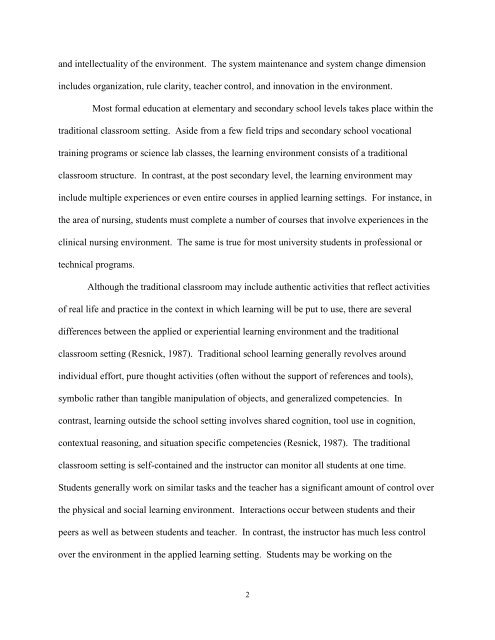STUDENT EVALUATION OF CLINICAL EDUCATION ENVIRONMENT
STUDENT EVALUATION OF CLINICAL EDUCATION ENVIRONMENT
STUDENT EVALUATION OF CLINICAL EDUCATION ENVIRONMENT
You also want an ePaper? Increase the reach of your titles
YUMPU automatically turns print PDFs into web optimized ePapers that Google loves.
and intellectuality of the environment. The system maintenance and system change dimension<br />
includes organization, rule clarity, teacher control, and innovation in the environment.<br />
Most formal education at elementary and secondary school levels takes place within the<br />
traditional classroom setting. Aside from a few field trips and secondary school vocational<br />
training programs or science lab classes, the learning environment consists of a traditional<br />
classroom structure. In contrast, at the post secondary level, the learning environment may<br />
include multiple experiences or even entire courses in applied learning settings. For instance, in<br />
the area of nursing, students must complete a number of courses that involve experiences in the<br />
clinical nursing environment. The same is true for most university students in professional or<br />
technical programs.<br />
Although the traditional classroom may include authentic activities that reflect activities<br />
of real life and practice in the context in which learning will be put to use, there are several<br />
differences between the applied or experiential learning environment and the traditional<br />
classroom setting (Resnick, 1987). Traditional school learning generally revolves around<br />
individual effort, pure thought activities (often without the support of references and tools),<br />
symbolic rather than tangible manipulation of objects, and generalized competencies. In<br />
contrast, learning outside the school setting involves shared cognition, tool use in cognition,<br />
contextual reasoning, and situation specific competencies (Resnick, 1987). The traditional<br />
classroom setting is self-contained and the instructor can monitor all students at one time.<br />
Students generally work on similar tasks and the teacher has a significant amount of control over<br />
the physical and social learning environment. Interactions occur between students and their<br />
peers as well as between students and teacher. In contrast, the instructor has much less control<br />
over the environment in the applied learning setting. Students may be working on the<br />
2












